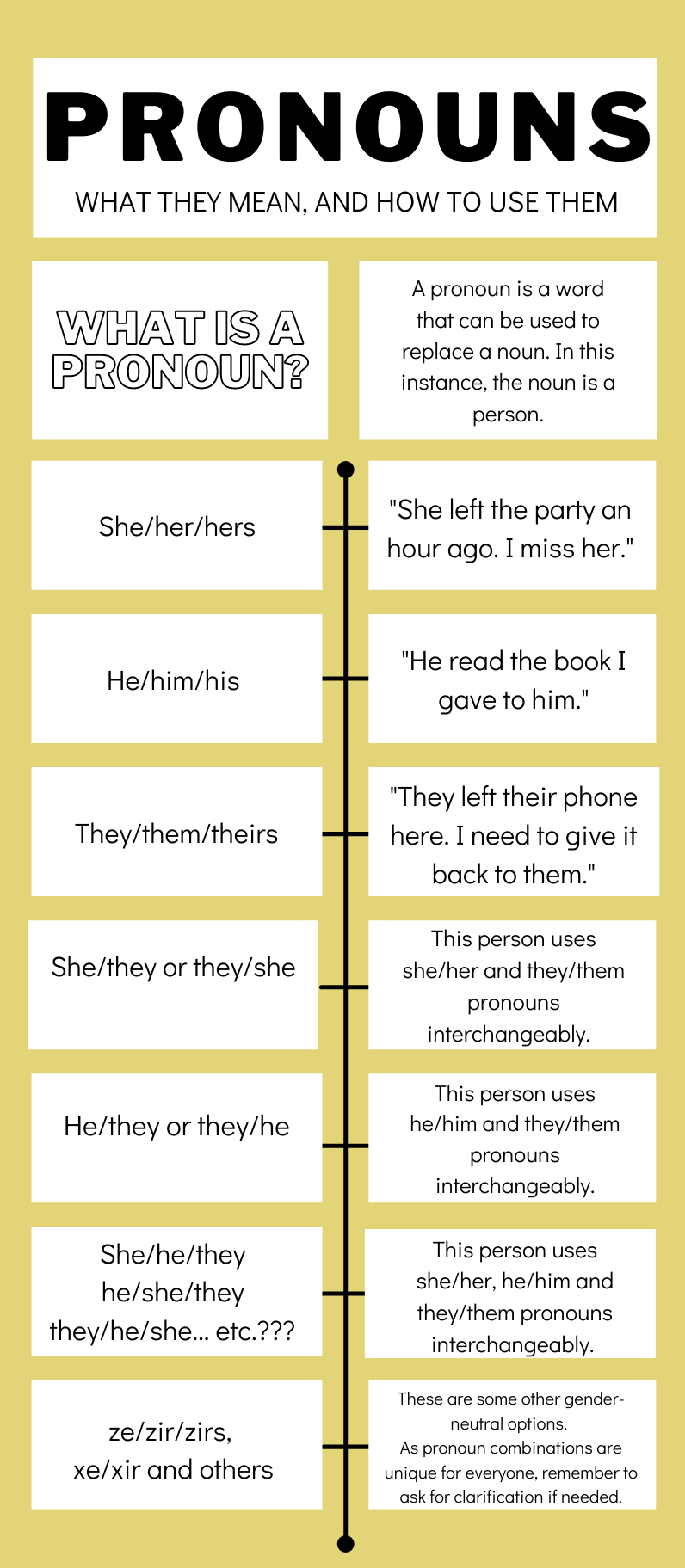Ari Collins
eSomethin staff
If scrolling through social media, one might see word pairings like ‘she/her,’ ‘he/him’ or ‘they/them’ displayed in profile bios or embedded within the captions of posts. These expressions may seem new, leaving many with questions—what are they and what do they mean?
These word combinations are not just words. They are pronouns. A pronoun is a word that is used to replace a noun—in this case, a person’s name—in a piece of writing or in speech. All people have pronouns. Just to name a few examples, some of the most common pronouns are he, her and they.
They are not only an essential element to the English language but also to gender and identity.
As a pronoun is to be used in place of a name, getting it right is necessary and part of basic respect. It is crucial to make every person feel respected as they are. It is especially important for those who do not identify with the gender assigned to them at birth to feel included and accepted.
Pronouns have been used for decades, even centuries, but are now being questioned or even ignored due in part to confusion. This new confusion is generally the result of non-binary or gender-neutral pronouns, specifically the use of the pronoun ‘they.’
‘They’ is the pronoun that has caused the most uproar because many people assume that using the pronoun ‘they’ for one person is grammatically incorrect. This is a wrong assumption. Yes, the world has been using ‘they’ as a plural pronoun, referring to more than one person, for years. What many do not consider is that it has been used as a singular pronoun for just as long.
‘Someone left their phone on the table, I hope they find it,’ is a perfect example. There is one phone and it belongs to one person. The speaker doesn’t assume that the owner of the phone is masculine or feminine. The identity of the phone owner is unknown, so the speaker uses a neutral pronoun. This is also a perfect example of how to use ‘they/them’ pronouns for a person who identifies with them.
A person’s pronouns can be ignored by speakers for many reasons but there are a few common ones—the speaker isn’t aware of a person’s pronouns and are assuming the gender of a person or they don’t know how to use pronouns.
Misgendering causes low self-esteem and leaves victims feeling stigmatized. Due to the harm it can cause, ignorance and misuse of pronouns is a real problem. But like most problems, there are ways to fix it.
Ways to be an ally
Using inclusive language in a group setting is one of the first steps to take as an ally. Even when not directly speaking to those who openly identify as non-binary, addressing groups with gender-neutral terms—like ‘everyone’ or ‘everybody’ instead of ‘ladies,’ ‘gentlemen’ and the like—is always a great idea.

It is a good idea to use inclusive language because it will help every person in a group feel comfortable. Some people may feel insulted or invalidated if addressed with certain terms, and it is important to recognize that this can happen. Using the right language creates an inclusive environment for everyone.
Don’t assume the gender of a person; ask about pronouns. The best way to do this is to share one’s own pronouns, as starting the conversation opens an accepting, comfortable space for everyone to share. For example, one could include pronouns in an introduction by saying, “Hi, my name is…I use the pronouns she and her.”
Another way to do this is to add pronouns into personal bios or in the closing of an email.
The last step is key: Take time to learn how to use pronouns correctly and use them regularly.
However, using a person’s pronouns naturally and correctly isn’t always easy for those who are just becoming knowledgeable on the subject. Everyone makes mistakes. If one accidentally uses the wrong pronouns, they should not emphasize the mistake, instead just correct it and move forward.
Pronouns matter, especially in schools
University of Toledo has recently proposed a policy that would require all students and staff members to use each others’ preferred names and pronouns in communication. Policies like this are a step in the right direction.
Although some schools may encourage similar policies and ideas, many schools have yet to become inclusive towards all students, as preferred names and pronouns are not integrated into student emails and accounts. Some students preferred names are not even on class rosters or in the yearbook. This is something that needs to change.
This is problematic because gender is a part of a student’s identity. And especially since students are figuring out their identities in high school, a safe space for expression is necessary.
To create a more respectful and accepting environment for all students—whether cisgender, transgender or non-binary—schools should encourage and use inclusive language in group settings, teach students and teachers how to use correct pronouns and create a safe space for students to express themselves.
Check out other stories on eSomethin!
- Opinion: Is High School Baseball A Dying Sport?
- Are phone policies getting stricter?
- Winter is just around the corner: here is what you need to know about Seasonal Affective Disorder (SAD)
- Perrysburg’s 2024 operating levy has failed – but what does that really mean?
- Girls Tennis Doubles Team Smashes Their Way Into State Tournament





